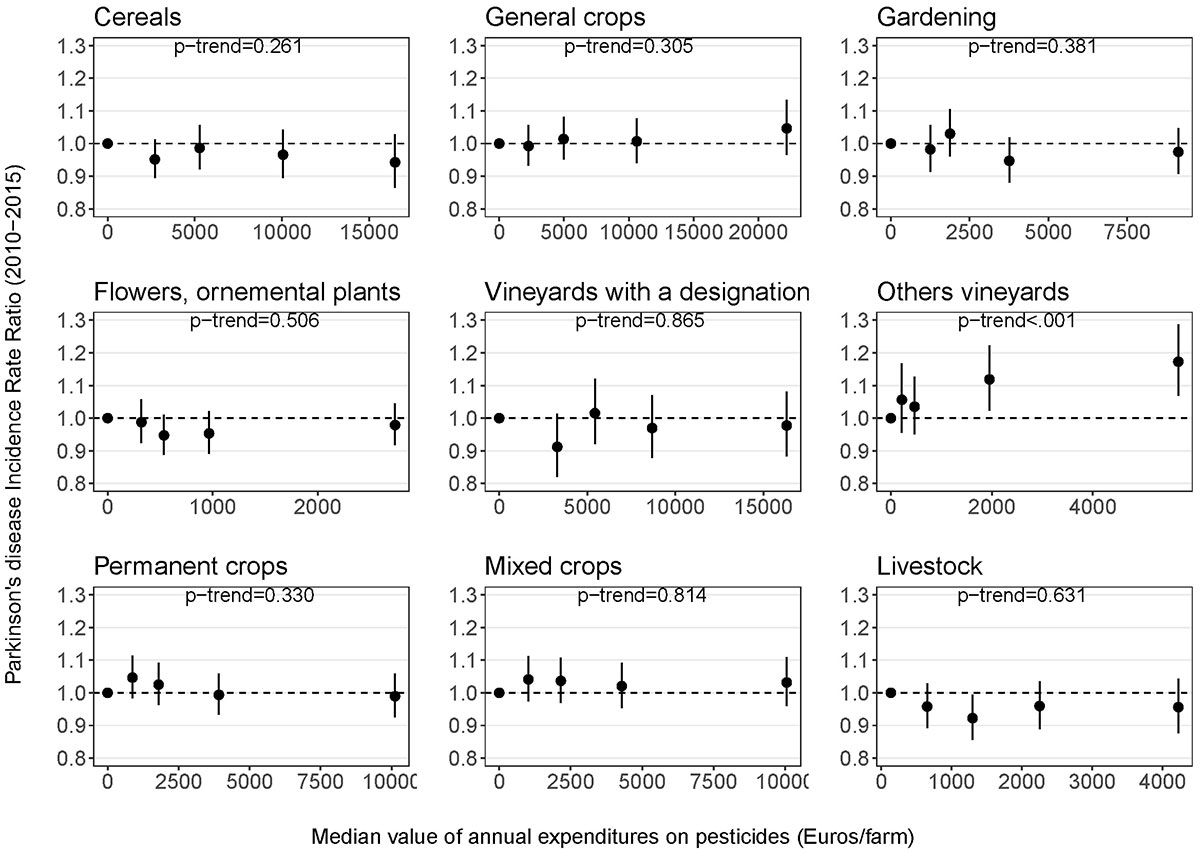Session Information
Date: Wednesday, September 25, 2019
Session Title: Epidemiology
Session Time: 1:15pm-2:45pm
Location: Les Muses, Level 3
Objective: We examined the association between expenditures on pesticides for several agricultural activities and incidence of Parkinson’s disease (PD) in French farmers.
Background: Epidemiological studies have shown an association between professional pesticide exposure and PD. Most of these studies included few exposed subjects, were based on self-reported exposure, did not take into account the target of pesticides, and enrolled prevalent cases.
Method: We identified incident PD cases (2010-2015) in small agricultural French regions (cantons, n=3571) among farmers enrolled in the French health insurance for agricultural workers and related occupations using a validated algorithm based on drug claims databases [1]. Annual expenditures on pesticides per hectare according to the main agricultural activity (n=9) and geographic region (n=22) of farms came from a survey carried out by the French ministry of agriculture in 2000 [2[. We computed expenditures on pesticides for each agricultural activity in the cantons based on the area devoted to each activity, and divided these figures by the corresponding number of farms (2000 agricultural census). We used multilevel Poisson regression, adjusted for the density of neurologists, smoking rates and a deprivation index to examine the association of expenditures on pesticides (in quintiles) with age/sex standardized incidence ratios of PD, and to estimate incidence rate ratios (IRR) and 95% confidence intervals (CI).
Results: We identified 10,282 incident cases (median number of cases per canton=2.5, range=0-23). PD incidence was 17.3% (95% CI = 6.9-28.7%) higher in cantons in the highest quintile of expenditures on pesticides for ‘other vineyards’ compared to cantons in the lowest quintile, with a significant linear trend (p-trend<0.001). There was no association with expenditures on pesticides for any other type of agriculture, including vineyards with a designation of origin (p-trend=0.865) [figure1].
Conclusion: PD incidence was higher in regions with more expenditures on pesticides for ‘other vineyards’ but not for ‘vineyards with a designation of origin’. A possible explanation is that pesticides use (products, application method, protection, …) differs in the two types of vineyards. Additional studies are needed in farmers in vineyards in whom preventive measures could help reduce exposure.
References: 1- Moisan F, Gourlet V, Mazurie JL, Dupupet JL, Houssinot J, Goldberg M, Imbernon E, Tzourio C, Elbaz A. Prediction model of Parkinson’s disease based on antiparkinsonian drug claims. Am J Epidemiol 2011;174:354-363 2- Réseau d’information comptable agricole (RICA) : http://agreste.agriculture.gouv.fr/_rica-france-microdonnees/article/rica-france-microdonnees
To cite this abstract in AMA style:
L. Perrin, J. Spinosi, L. Chaperon, S. Kab, F. Moisan, A. Elbaz. Expenditures on pesticides and incidence of Parkinson’s disease in French farmers: a nationwide study [abstract]. Mov Disord. 2019; 34 (suppl 2). https://www.mdsabstracts.org/abstract/expenditures-on-pesticides-and-incidence-of-parkinsons-disease-in-french-farmers-a-nationwide-study/. Accessed December 14, 2025.« Back to 2019 International Congress
MDS Abstracts - https://www.mdsabstracts.org/abstract/expenditures-on-pesticides-and-incidence-of-parkinsons-disease-in-french-farmers-a-nationwide-study/

